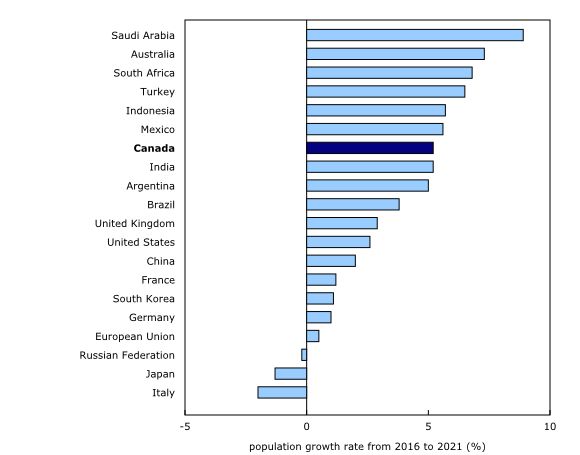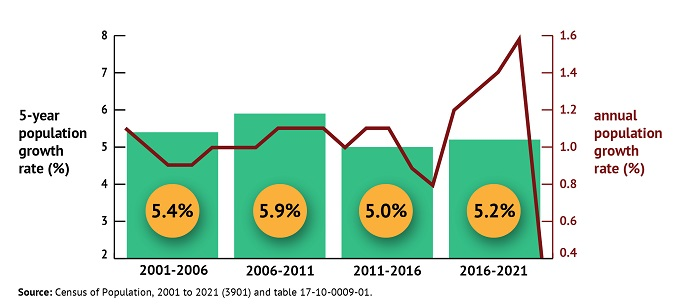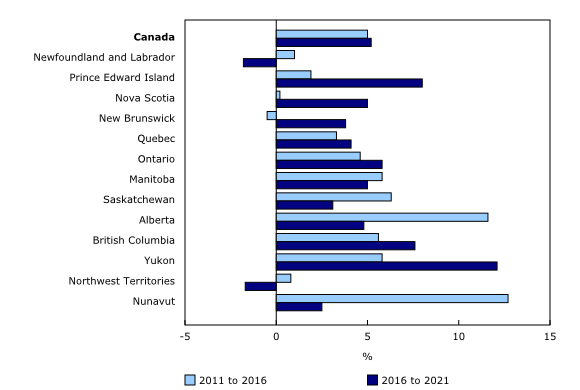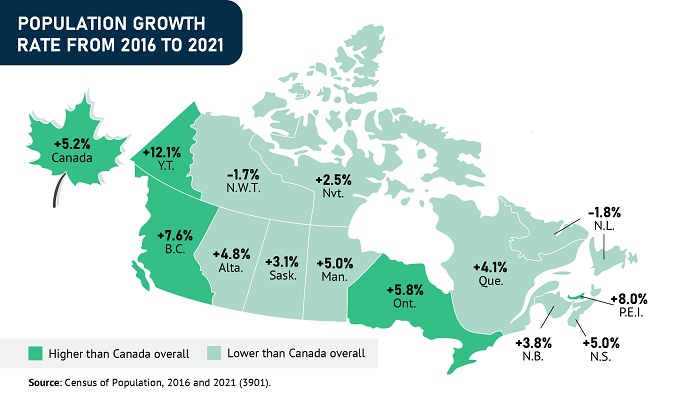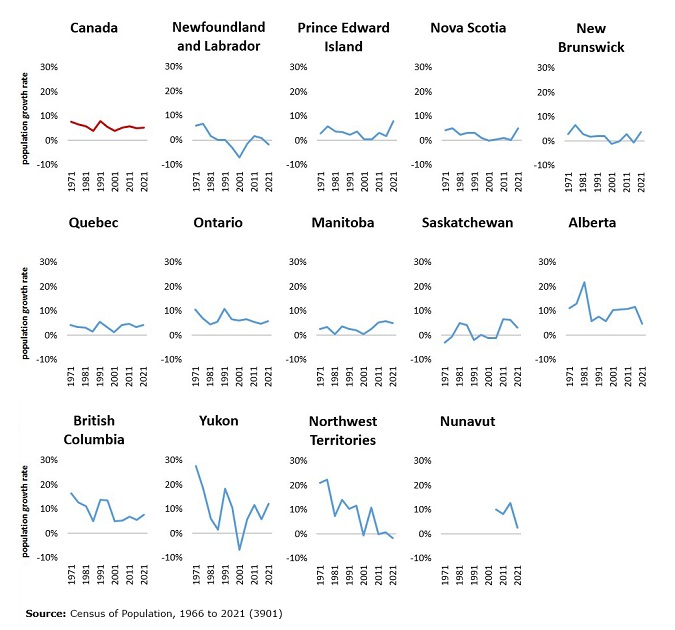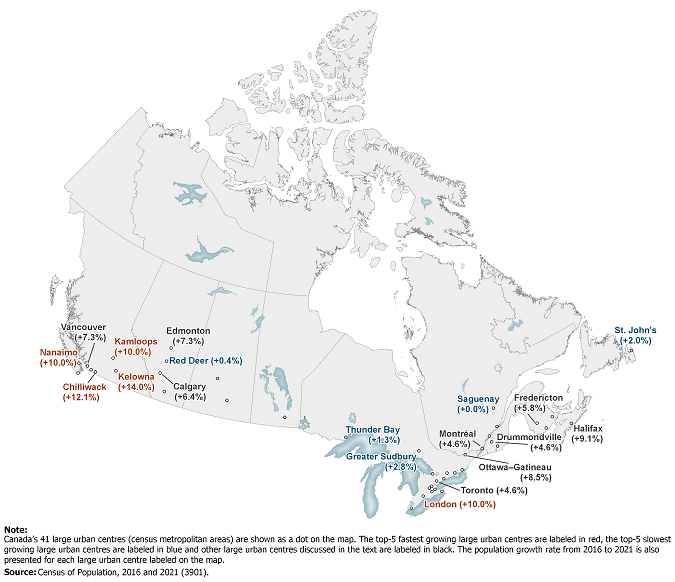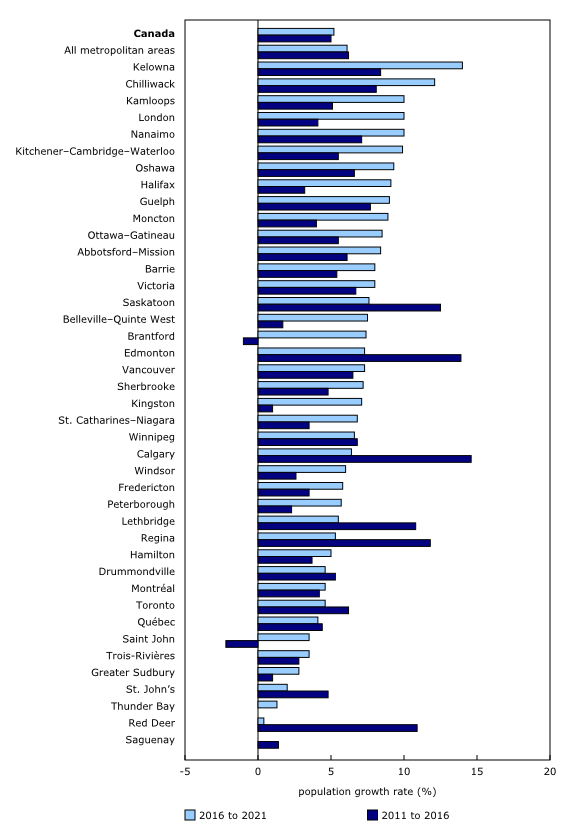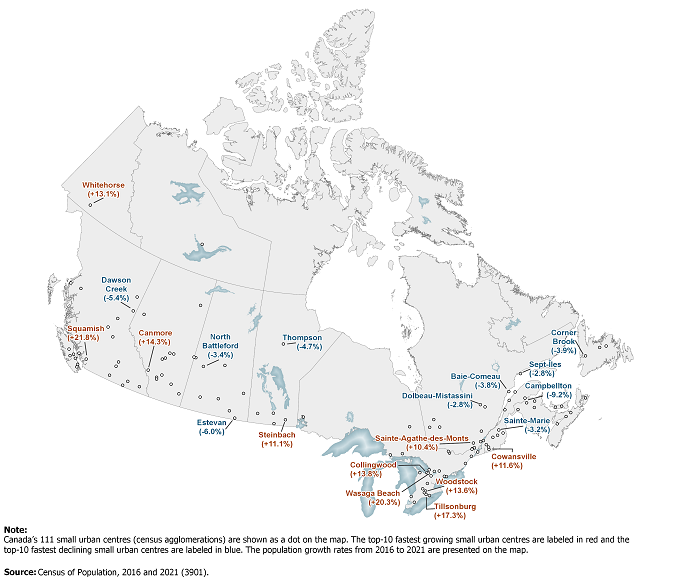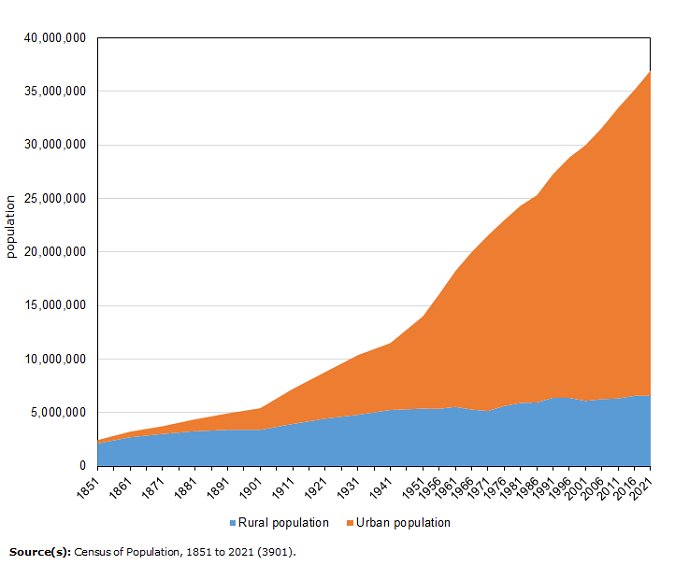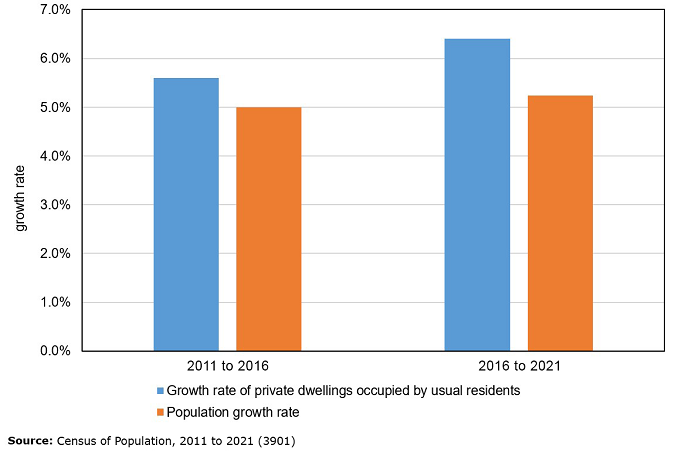Canada tops G7 growth despite COVID
Archived Content
Information identified as archived is provided for reference, research or recordkeeping purposes. It is not subject to the Government of Canada Web Standards and has not been altered or updated since it was archived. Please "contact us" to request a format other than those available.
Released: 2022-02-09
Our world has dramatically changed from the last time we took the pulse of the nation, in 2016, to the census we conducted in the spring of 2021. Thanks to Canadians who responded to the census during the third wave of the pandemic, we can better understand where we are at today as we continue to navigate this life changing pandemic.
One thing that has not changed from five years ago is that Canada remains the fastest growing country in the G7. Most of that growth is attributable to more people arriving here from around the world to start a new life. Approximately 1.8 million more people were calling Canada home in 2021 compared with five years earlier, with four in five of these having immigrated to Canada since 2016.
Although the onset of the pandemic slowed population growth from a record high in 2019 (up 583,000 or +1.6%) to its lowest growth rate in a century in 2020 (up 160,000 or +0.4%), Canada's pace of population growth remains the highest in the G7.
For the first time in the census since the 1940s, the population of the Maritimes grew at a faster pace than the Prairie provinces, due to rising immigration levels and an influx of Canadians migrating from other parts of the country. Conversely, the population of neighbouring Newfoundland and Labrador declined (-1.8%) from 2016 to 2021.
Yukon's population (+12.1%) grew at the fastest pace nationally from 2016 to 2021 and among the provinces, Prince Edward Island experienced the fastest growth (+8.0%).
Canada continues to urbanize. Among the 36,991,981 people living here in the spring of 2021, close to 27.3 million people, or nearly three in four Canadians, lived in one of Canada's 41 large urban centres.
Today, Statistics Canada is releasing the first results from the 2021 Census, including the number of Canadians counted, population growth across the country, and how the pandemic has affected the demographic makeup of the nation.
Over the coming months, Statistics Canada will be releasing the full results from the 2021 Census, which will paint a complete statistical portrait of the Canadian communities from coast to coast to coast.
Please see the 2021 Census release schedule to find out when data and analysis on the upcoming topics will be released throughout 2022.
Note about the PDF version of this release: due to formatting issues, the PDF version of this release may display some blank pages. Rest assured that the content is not compromised. The HTML version provides optimal viewing.
Highlights
Canada's population grew at almost twice the pace of other G7 countries from 2016 to 2021.
Although the pandemic halted Canada's strong population growth in 2020, it continued to be the fastest among G7 countries.
Canada is home to almost 37 million people, 1.8 million (+5.2%) more than in 2016. Most of the increase occurred prior to the pandemic, with Canada's population rising by a record high of 583,000 people (+1.6%) in 2019.
Immigration, not fertility, mostly drove Canada's population growth from 2016 to 2021 and was also the main reason for the slowdown since 2020 due to border restrictions put in place to curb the spread of COVID-19.
The population of the Maritimes grew at a faster pace than the Prairies for the first time in the census since the 1940s.
The population of Yukon (+12.1%) grew at the fastest pace nationally from 2016 to 2021, while Prince Edward Island (+8.0%) and British Columbia (+7.6%) had the highest growth rates among the provinces.
Newfoundland and Labrador (-1.8%) was the lone province to see its population decline from 2016 to 2021.
Canada continues to urbanize. The population rose in all 41 large urban centres from 2016 to 2021, with growth accelerating in most of them.
The census counted just over 6.6 million Canadians (6,601,982) living in a rural area in May 2021, up 0.4% compared with five years earlier, but well below the pace of growth in urban areas (+6.3%). Immigrants are far more likely to settle in an urban area than a rural setting, which explains most of the difference in growth.
In 2021, Canada had 41 census metropolitan areas with more than 100,000 people, up from 35 in the previous census. The six new large urban centres are Fredericton, Drummondville, Red Deer, Kamloops, Chilliwack and Nanaimo.
Resort destinations such as Squamish, British Columbia; Canmore, Alberta; as well as Wasaga Beach and Collingwood in Ontario, are among the fastest growing communities in Canada.
Within large urban centres, downtowns grew at a faster pace from 2016 to 2021 than during the previous census (2011 to 2016).
Canada's population growing at almost twice the rate of other G7 countries
Canada's population grew at almost twice the rate of every other G7 country from 2016 to 2021, rising 5.2% from 2016 to just under 37 million people in 2021 (see textbox Census counts, demographic estimates and census coverage studies).
Although the onset of the pandemic in 2020 halted Canada's rapid population growth, it continued to be the fastest among G7 countries.
While the pandemic slowed the movement of people around the world, immigration still contributed to Canada's population growing by 0.4% in 2020, the fastest pace of growth in the G7 for similar periods. By way of comparison, the population of the United States rose by 0.1% from July 1, 2020 to July 1, 2021.
Like most other G7 countries, Canada's population growth from 2016 to 2021 was largely attributable to immigration, accounting for nearly four-fifths of the population gain over this period, while one-fifth was due to natural increase (that is, the number of births minus the number of deaths).
The rate of natural increase fell 0.3% from 2016 to 0.1% in 2021, the lowest level on record. While Canada's pace of natural increase is low, unlike most other G7 countries, it is not expected to become negative (more deaths than births) within the next 50 years. The populations of Italy and Japan are already declining due to more deaths than births and low immigration rates.
However, the pandemic not only slowed the arrival of immigrants from other lands, it may also have impacted fertility rates. A recent study suggests that one-fifth of Canadian adults under the age of 50 wanted to have fewer children than previously planned or delayed having children as a result of the pandemic. Prior to the pandemic, fertility in Canada had been decreasing since 2015 and hit a record low of 1.4 children per woman in 2020.
Canada's population growth ranked seventh in the G20 from 2016 to 2021, trailing Saudi Arabia, Australia, South Africa, Turkey, Indonesia and Mexico and on par with India.
Census counts, demographic estimates and census coverage studies
The number of Canadians we counted during the 2021 Census may differ from the demographic estimates or the population modelled according to the population clock for a similar date.
The Census of Population provides a snapshot of the population at a specific moment in time (May 11, 2021, for this census) and its consistent methodology allows for robust historical comparisons with data from previous censuses. Inevitably, however, some people were not counted, or were counted more than once, for various reasons.
COVID-19 presented some challenges for conducting the 2021 Census of Population but despite these, the collection response rate for the country as a whole was a resounding success at 98.0%, thanks to Canadians who completed the census in the midst of the third wave of the pandemic. Additionally, unique challenges were encountered in Northern or remote regions of the country, such as travel restrictions, border closures, shorter and shifted collection periods, unavailability of local staff, and wildfires. Ensuring the health and safety of Canadians and our employees by adapting our collection operations to ensure high quality, trusted census data was a high priority for Statistics Canada.
As we do after every census, Statistics Canada conducts undercoverage and overcoverage studies to determine the number of people who were omitted or enumerated more than once and releases the results in the year following the first release of census counts. The difference between undercoverage and overcoverage is called net undercoverage. These study results are used in conjunction with the census counts to produce demographic estimates that take into account net undercoverage.
Statistics Canada's demographic estimates complement the census counts and are available for Canada, the provinces, the territories and various subprovincial geographic levels on a more frequent basis (quarterly and annually). Among other things, they are used each year by the Department of Finance Canada to calculate transfer payments from the federal government to the provinces and territories.
Canada's population clock (modelled in real time) is also based on data from demographic estimates.
Immigration drives Canada's population growth
Canada's population growth has largely been driven by immigration since the 1990s as Canadian couples, like those in other G7 countries, are having fewer children on average than ever before. In Canada, immigration (new arrivals to Canada) has largely exceeded emigration (those who leave Canada) resulting in migratory increase that has fueled population growth. Immigration targets for permanent and temporary immigrants have also risen since 2015.
The share of population growth due to natural increase has been falling in Canada because of population aging and lower fertility.
Nearly four-fifths of the 1.8 million population increase from 2016 to 2021 was attributable to new arrivals to Canada either as permanent or temporary immigrants.
Immigration continues to be the main driver of population growth for almost all provinces and territories. Prince Edward Island and British Columbia showed the fastest growth rates among the provinces, mostly due to immigration.
Strong population growth halted by pandemic
Canada's 5.2% population growth rate (or +1,840,253 people) from 2016 to 2021 was larger than the previous census cycle from 2011 to 2016 (+5.0%, or +1,675,040 people). Most of this growth, however, occurred from 2016 to 2019.
Canada's population grew at its fastest pace since the end of the 1980s from 2016 to 2019, reaching a record high annual increase of more than 583,000 people (or +1.6%) in 2019.
In 2020, however, the pandemic virtually halted population growth mainly due to global border and travel restrictions implemented to slow the spread of COVID-19, which drastically reduced the number of permanent and temporary immigrants arriving in Canada. In fact, the international migratory increase in 2020 was less than one-quarter of what it was a year earlier.
The marked slowdown in population growth in 2020 was almost entirely due to the pandemic induced pause in immigration. Although there were more than 30,000 Canadians who died as a result of COVID-19 by the end of 2021, making it the third leading cause of death in Canada following cancer and heart disease, COVID-19 deaths had a limited effect on the slowdown in Canada's population growth. For example, new arrivals of permanent immigrants were down by almost half, falling from 341,000 in 2019 to 185,000 in 2020, while the number of deaths increased from 285,000 to 307,000, with much of the increase due to COVID-19.
As a result, Canada's population grew 0.4% from January 1 to December 31, 2020—the slowest pace of growth since the First World War.
Since mid-2021, the most recent quarterly demographic estimates from Statistics Canada suggest that Canada's population growth is back to pre-pandemic levels.
In particular, the number of new immigrants has risen sharply since April 2021, a trend that continues to this day. Statistics Canada's Demographic Estimates Program will track whether Canada's population continues to grow over the next few months. Statistics Canada also displays a population clock, based on a model, allowing Canadians to better understand population changes in real time.
The population of the Maritimes growing at a faster pace than the Prairies for the first time in the census since the 1940s
Population growth accelerated in Prince Edward Island, New Brunswick, and Nova Scotia over the past five years when compared with the previous census cycle (from 2011 to 2016), while population growth slowed in Manitoba, Saskatchewan and Alberta.
As a result, for the first time in the census since the 1940s, the population of the Maritimes (+4.7%) grew at a faster pace than the Prairie provinces (+4.6%).
Population growth also accelerated in Canada's three largest provinces of Ontario, Quebec and British Columbia.
The impacts of the pandemic on population growth were felt from coast to coast to coast due to lower levels of permanent and temporary immigration. Growth slowed but remained positive in eight provinces and all three territories after the onset of the pandemic. The already declining population of Newfoundland and Labrador fell further in 2020 (-0.7%), while population growth halted in Saskatchewan (-0.0%).
Population of the Maritimes growing at its fastest pace since the early 1970s
From 2016 to 2021, the populations of New Brunswick and Nova Scotia grew at their fastest pace since the early 1970s, with Prince Edward Island, Canada's least populated province, posting its highest population growth rate on record.
Newfoundland and Labrador (-1.8% to 510,550) was the lone province to see a population decline from 2016 to 2021.
Prince Edward Island led the provinces with an 8.0% population increase from 2016 to 154,331 in 2021.
The population growth of Nova Scotia (+5.0% to 969,383) almost matched Canada's overall growth and follows five censuses during which the province's growth rate never surpassed 1.0%.
There were 3.8% more people living in New Brunswick in 2021 compared with five years earlier, reaching 775,610 people, following a 0.5% drop from 2011 to 2016.
Two key factors explain the increased population growth in the Maritimes.
First, New Brunswick, Nova Scotia and Prince Edward Island welcomed a record number of immigrants from 2016 to 2021, the vast majority arriving prior to the pandemic. Although approximately one-third to one-half of those who immigrate to the Maritimes move to another province within five years of arrival, higher levels of immigration were still mainly responsible for the rebound in population growth since 2016.
Second, for the first time since the 1981 to 1986 intercensal period, more people moved to the Maritimes from other parts of Canada (134,841) than moved away (98,086). The positive influx of people into these provinces from elsewhere in Canada started prior to the pandemic but has intensified thereafter. This change may be partly related to the increased possibility of working from home, combined with larger economic disruptions in other parts of Canada and the lower costs of housing in the Maritimes.
Were it not for these international and internal migratory increases, the population of all three Maritime provinces would likely have fallen since, like Newfoundland and Labrador, they all recorded more deaths than births from 2016 to 2021.
Population growth accelerates in Ontario and Quebec
Ontario's population (+5.8% to 14,223,942) grew at a faster pace than Canada's overall population from 2016 to 2021, the first time this has happened since the 2006 Census. This acceleration in population growth compared with previous intercensal periods was largely due to higher levels of immigration prior to the pandemic.
Ontario welcomed almost twice as many permanent and temporary immigrants from 2016 to 2021 compared with the previous five-year census cycle.
Quebec's population also grew at a faster pace (+4.1% to 8,501,833) from 2016 to 2021 compared with the previous census cycle (+3.3%). Most of the growth was also due to international migration pre-pandemic. Permanent and temporary immigration increased compared with 2011 to 2016, to account for about four-fifths of the population growth from 2016 to 2021.
Western Canada: Population growth exceeds national average in British Columbia, slows on the Prairies
Results of the 2016 Census showed that Alberta, Manitoba and Saskatchewan were the provinces with the fastest growth rates. However, five years later, this is no longer the case.
The 2021 Census marked the first time that the population of British Columbia exceeded five million people (5,000,879). This province was the lone province in Western Canada where population growth (+7.6%) exceeded the national average of 5.2%.
British Columbia was also the lone province in Western Canada that saw more people move into the province from elsewhere in Canada than move out from 2016 to 2021, with interprovincial migration gains (+97,424) reaching their highest level since 1991 to 1996.
The populations of Manitoba (+5.0% to 1,342,153), Saskatchewan (+3.1% to 1,132,505) and Alberta (+4.8% to 4,262,635) all grew from 2016 to 2021, albeit at a slower pace compared with 2011 to 2016 when they led the provinces.
After leading the provinces in population growth for five consecutive censuses, Alberta ranked sixth in 2016 to 2021, behind Prince Edward Island, British Columbia, Ontario, Nova Scotia and Manitoba.
Similar to Canada overall, immigration was the main driver of population growth in Western Canada. However, international migration levels have changed little in Western Canada since the last intercensal period, unlike in most other provinces, where they rose significantly prior to the pandemic. This partially explains why Manitoba, Saskatchewan and Alberta no longer lead the provinces in population growth.
Alberta, Manitoba and Saskatchewan also all saw more people move out of province than move in from other parts of Canada against a backdrop of lower oil prices that started in 2014 and higher unemployment, especially in Alberta.
For Alberta, this marked the first decline in interprovincial migration over a five-year census period since 1986 to 1991.
Population growth remains high in Yukon, but slows in Nunavut and decreases in the Northwest Territories
While Yukon (+12.1% to 40,232) led the country in population growth, it was the sole territory that grew at a faster pace than Canada overall.
The first results of the 2021 Census show Nunavut (+2.5% to 36,858) grew at a slower pace than the national average, while the population of the Northwest Territories fell (-1.7% to 41,070).
Nunavut and the Northwest Territories are the only ones among the provinces and territories in Canada where population growth relies mainly on natural increase. This is because these two territories have much higher fertility rates than elsewhere in Canada, and are consequently younger.
Quebec's population share continues to decrease
Quebec, Canada's second most populous province (8.5 million people), saw its share of the total population decline for the 11th consecutive census, falling from 23.2% in 2016 to 23.0% in 2021, despite its population growing at a faster pace compared with the previous intercensal period (2011 to 2016).
Almost two in five of the 37 million Canadians counted were living in Ontario (38.5%, or 14.2 million people) in 2021, up from 38.3% in 2016.
Atlantic Canada's (2.4 million) share of the total population fell from 6.6% in 2016 to 6.5% in 2021.
In contrast, the share of the total population in Western Canada (Manitoba, Saskatchewan, Alberta and British Columbia—11.7 million people) increased from 31.6% to 31.7%.
Approximately 0.3% of Canadians or 118,000 people were living in the three territories at the time of the census.
According to the average growth scenario of our most recent population projections, Canada's population could reach 55.2 million by the end of the 2060s.
Nearly three in four Canadians live in one of Canada's 41 largest urban centres
Canada has continued to urbanize since the 2016 Census, with the population growth rate of urban centres outpacing the growth occurring elsewhere.
In 2021, Canada had 41 census metropolitan areas (CMAs) with more than 100,000 people, up from 35 in the previous census and further evidence of the increasing urbanization of Canada. The six new large urban centres are Fredericton, Drummondville, Red Deer, Kamloops, Chilliwack and Nanaimo. Close to 27.3 million people, or nearly three in four Canadians, lived in a CMA at the time of the census.
Over one-third of Canadians (13.1 million people) live in the three largest CMAs of Toronto, Montréal and Vancouver.
Toronto (6,202,225 people) remains the most populous CMA, followed by Montréal (4,291,732 people) and Vancouver (2,642,825 people).
Three other CMAs had a population of over one million inhabitants in 2021. Ottawa–Gatineau (1,488,307 people) regained fourth place after temporarily losing that title in 2016 to Calgary (1,481,806 people), which fell back to fifth place but remained the most populous CMA in Alberta. Edmonton (1,418,118 people) remained the nation's sixth largest CMA.
Population growth accelerates in most major urban centres
Population growth in large urban centres relies much more on immigration than other areas of Canada, with more than 9 in 10 new permanent immigrants settling in a CMA. From 2016 to 2019, record levels of international migration accelerated population growth in most of Canada's major metropolitan areas.
Outside of these large urban centres, population growth was generally slower or in some cases negative. As a result, Canada continues to urbanize.
For example, the populations of 22 of the 27 CMAs in Atlantic Canada, Quebec and Ontario increased at a faster pace from 2016 to 2021 compared with the previous census cycle (2011 to 2016). In British Columbia, population growth accelerated in all of its seven CMAs.
In contrast, the populations of the seven CMAs in Alberta, Manitoba and Saskatchewan all grew at a slower pace from 2016 to 2021 compared with the previous census cycle.
For the first time in over 25 years, Calgary no longer ranks among the five fastest growing CMAs in the country.
In addition, for the first time in six censuses, no CMA in Canada saw a population decline from 2016 to 2021.
The population of Canada's two largest CMAs—Toronto and Montréal—grew at the same pace (+4.6%) from 2016 to 2021. The pace of growth was slower compared with the previous census in Toronto (+6.2% from 2011 to 2016) and slightly faster in Montréal (+4.2% from 2011 to 2016).
Although the growth rates of Toronto and Montréal were below the national average of 5.2% from 2016 to 2021, they received a record influx of permanent or temporary immigrants from 2016 to 2019. Nevertheless, the population gained through immigration was partially offset by losses to neighbouring areas (intraprovincial migration).
The population growth of most Canadian large urban centres was impacted by the pandemic related border restrictions in 2020 and the ensuing slowdown in immigration, according to annual demographic estimates.
For example, the pace of growth in the Toronto CMA slowed from 1.4% in 2019/2020 to 0.2% in 2020/2021 as a result of lower immigration. It was also the first time in the recent past that the population in the Montréal CMA declined over the course of one year, falling 0.6% from July 1, 2020, to July 1, 2021. Both CMAs posted record population losses to other regions within their respective province in 2020/2021.
Conversely, the populations of Halifax and Kelowna were among the fastest growing CMAs nationally from 2016 to 2021 and since the onset of the pandemic, with much of the recent growth attributable to Canadians moving there from elsewhere in Canada. In particular, Halifax attracted many migrants from Ontario from 2020 to 2021, perhaps due to more Canadians being able to work from home as well as lower housing costs.
For more detailed results about population growth inside Canada's largest urban centres, particularly in regard to the growth of downtown areas and urban spread, please see the second Daily article released today entitled "Canada's large urban centres continue to grow and spread."
Mid-sized metropolitan areas also growing at a faster pace, particularly in British Columbia
Four of the five fastest growing CMAs in the country were located in British Columbia from 2016 to 2021: Kelowna (+14.0% to 222,162), Chilliwack (+12.1% to 113,767), Nanaimo (+10.0% to 115,459) and Kamloops (+10.0% to 114,142). Much of the growth of these four CMAs in British Columbia occurred because they attracted people from elsewhere in Canada and from within the province.
Conversely, in London, Ontario (+10.0% to 543,551), the population growth was mainly due to permanent and temporary immigration.
Smaller urban centres home to 1 in 10 Canadians
More Canadians are calling resort destinations home
In addition to Canada's 41 largest metropolitan areas, the country has 111 census agglomerations (CAs), which are smaller urban areas ranging from about 10,000 to 100,000 people. In 2021, 3.8 million people or 10.1% of Canadians lived in one of these CAs.
Squamish, British Columbia (+21.8% to 24,232) was the fastest growing CA from 2016 to 2021.
Meanwhile, 4 of the 10 fastest growing CAs were in Ontario: Wasaga Beach (+20.3% to 24,862), Tillsonburg (+17.3% to 18,615), Collingwood (+13.8% to 24,811) and Woodstock (+13.6% to 46,705).
Several of the smaller urban centres are known for being tourist destinations or resort cities. More specifically, four of those destinations—Squamish (+21.8% to 24,232), Wasaga Beach (+20.3% to 24,862), Canmore (+14.3% to 15,990) and Collingwood (+13.8% to 24,811)—were among the five fastest growing CAs in the country.
These destinations are all characterized by their proximity to nature and the existence of outdoor facilities nearby, such as ski stations, large parks, beaches or navigable bodies of water. While being close to nature, these small urban centres are not among the most remote and are generally less than a one-hour drive from a large urban centre, meaning they are also close to the amenities of larger urban centres.
All four of these resort CAs attracted migrants from other areas in their respective provinces, a factor that explains practically all the population growth in Wasaga Beach and Collingwood. Their outdoor facilities and their optimal location may have attracted people from larger metropolitan areas, such as young retirees or those able to work from home in search of greater proximity to nature.
Overall, 27 of the 111 CAs saw their populations decline from 2016 to 2021. Campbellton, New Brunswick (-9.2% to 13,330) saw the largest population decline among the CAs from 2016 to 2021. CAs with the largest population declines were often located in more remote areas, such as Dawson Creek, British Columbia (-5.4% to 17,878), Thompson, Manitoba (-4.7% to 13,035) and Corner Brook, Newfoundland and Labrador (-3.9% to 29,762). Most often, CAs with a shrinking population experienced more people moving elsewhere in the province or outside of the province altogether.
The population of rural Canada is growing, but at a much slower pace than urban Canada
While still on the rise, the population of rural Canada has grown at a slower pace than in urban centres.
The census counted just over 6.6 million Canadians (6,601,982) living in a rural area in May 2021, up 0.4% compared with five years earlier, but well below the pace of growth of urban areas (+6.3%).
As a result, the share of Canadians living in rural areas declined for the ninth consecutive census, falling from 18.7% in 2016 to 17.8% in 2021.
Why are rural populations increasing at a slower pace than urban areas?
Immigrants are far more likely to settle in an urban area rather than a rural setting. Also, many rural areas often lose people who move to urban centres. Canadians living in rural areas are also older on average than those living in urban centres and therefore the number of deaths exceeded the number of births in the rural areas of six provinces from 2016 to 2021. The next 2021 Census release on April 27, 2022, will shed more light on Canada's youngest and oldest populations.
The gap between rural and urban growth might have been more pronounced were it not for the pandemic.
The drop in immigration caused by border restrictions had a much larger impact on population growth in large urban centres compared with rural areas. With more Canadians now being able to work from home as a result of the pandemic, the population of some rural areas grew as more people moved out of urban centres, particularly in Quebec and Ontario.
The rural population increased in five provinces from 2016 to 2021, and declined in Newfoundland and Labrador (as was the case for the population of the province as a whole), New Brunswick, and in Manitoba, Saskatchewan and Alberta.
Learn more about how Canada's cities are growing
The census is the foundation of highly disaggregated data for Canada and provides high quality data for small areas across the country. Complementary analyses of recent population growth in Canadian municipalities and in the downtowns of the nation's largest urban centres are also released today in "Canada's fastest growing and decreasing municipalities from 2016 to 2021."
Yukon and Prince Edward Island report largest growth rates in private dwellings occupied by usual residents
We counted just under 15 million private dwellings occupied by a usual resident in 2021, up 6.4% compared with 2016 and a faster pace of growth compared with the previous census cycle (+5.6% from 2011 to 2016). The number of dwellings rose in every province and territory.
The number of private dwellings grew at the fastest pace in Yukon (+12.9%), in line with its population growth, which was also the highest in Canada. Prince Edward Island (+8.6%) led the provinces in new private dwellings, followed by British Columbia (+8.5%) and Alberta (+6.9%).
Nunavut (+1.1%), the Northwest Territories (+1.5%) and Newfoundland and Labrador (+2.1%) reported the smallest increases in private dwellings, coinciding with population declines or low population growth in these areas.
Looking ahead: Telling the stories of Canadians
The 2021 Census data to be released over the coming months will tell many rich stories of Canadians and paint the portrait of our country in the context of the COVID-19 pandemic. This first release shows how and where our population has grown from 2016 to 2021, mainly due to record levels of immigration pre-pandemic. The next release, on April 27, 2022, will look at the pace of population aging and showcase Canada's communities with the oldest and youngest populations. For the first time, we will release census information about gender diversity in Canada. Other releases will also take a look at the living arrangements of young adults to see how they may have been affected by the pandemic—and there are many other stories to come. Census data are relied upon by governments, businesses, communities and Canadians to make informed decisions in areas such as immigration policies, economic development, social programs, urban planning, community well-being and where to live.
Note to readers
Canadians are encouraged to download the StatsCan app to view the census results.
Definitions, concepts and geography
The population growth rates reported in this document are calculated as the difference in population size between two dates (two censuses, for example), divided by the population of the earlier date, expressed as a percentage change.
All data and results presented in this document are based on the 2021 geographic boundaries.
According to the geographic boundaries of the 2021 Census, Canada now has 41 census metropolitan areas (CMAs) and 111 census agglomerations (CAs). Readers can consult the CMA and CA reference maps.
The six new CMAs are Fredericton (New Brunswick), Drummondville (Quebec), Red Deer (Alberta), Kamloops (British Columbia), Chilliwack (British Columbia) and Nanaimo (British Columbia).
In addition, the CMA of Ottawa–Gatineau was expanded to include the former CAs of Arnprior and Carleton Place. Similarly, the CMA of Windsor was expanded to include the former CA of Leamington.
Two former CAs from the 2016 Census ceased to be CAs in the 2021 Census: Bay Roberts (Newfoundland and Labrador) and Cold Lake (Alberta).
Five new CAs have been added since the 2016 Census: Sainte-Agathe-des-Monts (Quebec), Amos (Quebec), Essa (Ontario), Trail (British Columbia) and Ladysmith (British Columbia).
For detailed definitions of CMAs and CAs, please refer to the Census Dictionary.
2021 Census of Population products and releases
Today, Statistics Canada is releasing the first results from the 2021 Census of Population. These results focus on the growth in population and dwellings from 2016 to 2021 at the national, provincial and territorial levels, as well as for various subprovincial geographical levels.
Several 2021 Census products are also available today on the 2021 Census Program web module. This web module has been designed to provide easy access to census data, free of charge.
Analytical products include two articles in The Daily and two articles in the Census in Brief series.
Data products include the population and dwelling counts for a wide range of standard geographic areas, available through the Census Profile and Highlight tables.
Focus on Geography provides data and highlights on key topics found in this Daily release and in the Census in Brief articles at various levels of geography. In addition, a new data visualization, Ranking of the 10 most populated municipalities, 1901 to 2021, is now available.
Reference materials are designed to help users make the most of census data. They include the Guide to the Census of Population, 2021, the Dictionary, Census of Population, 2021, and the 2021 Census of Population questionnaires. Both the Dictionary and the Guide are updated with additional information throughout the release cycle.
Geography-related 2021 Census Program products and services can be found under Geography. This includes GeoSearch, an interactive mapping tool, and thematic maps, which show data for various standard geographic areas, along with the Focus on Geography and Census Program Data Viewer, which are data visualization tools.
Over the coming months, Statistics Canada will continue to release results from the 2021 Census of Population, and provide an even more comprehensive picture of the Canadian population. Please see the 2021 Census release schedule to find out when data and analysis on the different topics will be released throughout 2022.
Contact information
For more information, or to enquire about the concepts, methods or data quality of this release, contact us (toll-free 1-800-263-1136; 514-283-8300; infostats@statcan.gc.ca) or Media Relations (statcan.mediahotline-ligneinfomedias.statcan@statcan.gc.ca).
- Date modified:




